Tara and Kincora, the RUC link
by Roy Garland
RUC officers were members of Tara. A Kincora whistle blower received death threats. 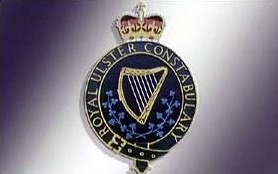
Introduction
Roy Garland was an associate of William McGrath, the infamous housefather of Kincora Boys’ Home. Garland discovered McGrath’s true nature long before McGrath was sent to work at Kincora. McGrath was a paedophile and sexual predator. Garland discovered this through his involvement in Faith House in Belfast where McGrath ran a Christian mission. Garland has written about Faith House on this website: Faith House, the roots of the Kincora Boys’ Home child sex abuse scandal. The abuse at Faith House has never been investigated. By Roy Garland, who knew William McGrath.
Garland made numerous efforts to halt McGrath’s abuse of boys. On 23 May 1973, he rang the RUC on a confidential line. His complaint was recorded in a log in 1973. It is reproduced below.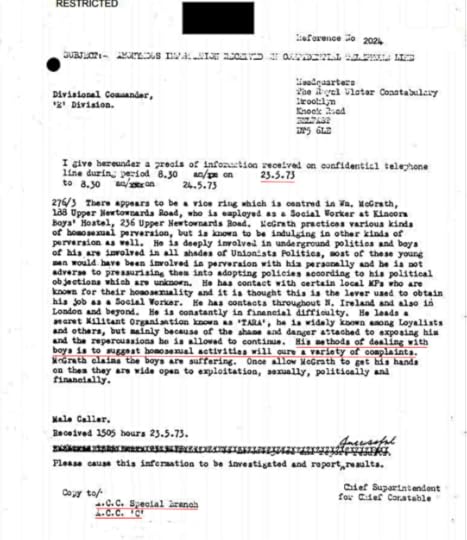
The RUC did not act on the report. This hardly surprising as MI6, MI5 and the RUC special branch ran the Kincora operation.
In 2022, the Police Ombudsman of NI (PONI) released the latest report about the Kincora scandal. It was a response to criticisms by seven former Kincora residents about complaints of abuse at the home which had been ignored by the force. The PONI report confirmed the obvious, namely that former RUC ‘officers failed in their duty to the victims of Kincora because they did not act on the information provided to them during the 1973-1976 period’. This confirms – officially – that the RUC knew about the scandal and did nothing.
McGrath was the commander of Tara. In this article, Garland explains that a number of RUC men were in Tara.
In this article, Garland explains how he tried to help an RUC officer’s inquiries into Kincora.
Roy Garland, an extraordinarily courageous man, put his life on the line. He suffered a number of death threats both before and after the Kincora scandal erupted.
1. RUC Men were members of Tara.
I was once a member of Tara but left it in the early 1970s
Tara’s leader was William McGrath. He was a paedophile who abused children for decades. He was finally exposed by The Irish Independent in 1980 as part of the Kincora scandal. He received a prison sentence in 1981.
I understand that some RUC were members of Tara, and that McGrath was working informally with a British Intelligence Agency making it difficult to have him face justice. There were also efforts to prevent a full investigation after the media exposed him because of McGrath’s secret role in Intelligence.  Roy Garland
Roy Garland
I first came across McGrath at Faith House, long before he went to work at Kincora.
A number of attempts were made to kill me both before and after the Kincora Boys’ Home sex abuse scandal erupted in January 1980.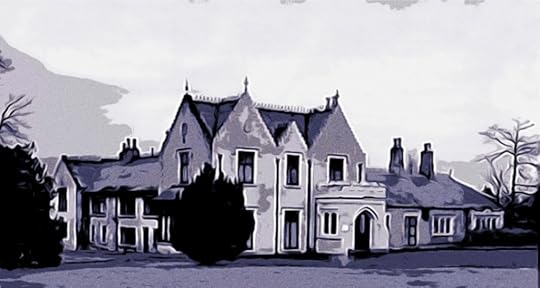 Faith House
Faith House
2. DC Cullen of the RUC investigates and then covers up McGrath’s wrongdoing.
One of those who investigated McGrath in the 1970s was DC Jim Cullen of the Royal Ulster Constabulary (RUC). He came across links between Donegall Pass RUC, Tara and Jay Wyatt, a Tara platoon leader.
DC Jim Cullen needed more evidence about McGrath’s abuse of boys, so I introduced a young witness who had been abused by him more recently. He insisted I stay throughout what turned out to be an unusual “interview”. No questions were asked. The young man told his story while Cullen and I listened to him.
Cullen later denied the interview had taken place.
Yet we were both present while the young man told his story at the RUC Station. I assumed it was being secretly recorded but no record has as yet come to light despite recent inquiries such as that of the Police Ombudsman Northern Ireland (PONI) of 2022, and the Hart Inquiry of 2017.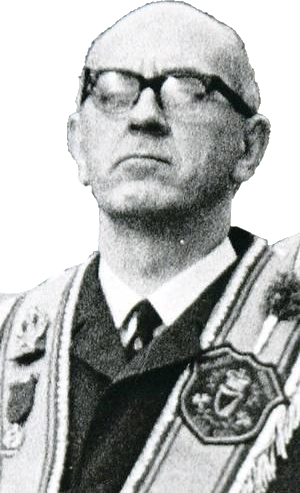 William McGrath
William McGrath
DC Cullen later claimed the young witness and I “had made new lives…and didn’t feel they could go through with it.” This was untrue, we were not making new lives and were never asked to go through with this. In fact DC Cullen was not keen because he was facing serious threats.
In bearing witness the young man also took risks when gunmen were asked to assassinate me.
I was told to keep a low profile and that the threat would remain while the assassins lived and I might have to flee the country.
3. The Kincora file sent to Assistant Chief Constable which was lost in the post.
Jim Cullen’s last contact with his boss, Assistant Chief Constable William Meharg, about Kincora, took place in 1976 when Cullen sent him a copy of a Health Board file on Kincora and other material by “internal post” but “Meharg said it never arrived.” In response DC Cullen said later:
…it never occurred to me that there was a cover-up…but I did as time went on. I wondered why nothing was being done. I would have liked to have done more…but had no authority. It had to come from above … from Meharg.
4. Davy Payne of the UDA.
I believe there were at least three plans for my assassination, but I survived perhaps because I had good friends in many places.
A warning was posted at the end of the street saying, “Roy Garland is a traitor to the people of Ulster” and my name appeared on a local bonfire.
After this I met Davy Payne of the UDA on the Shankill Road near Agnes Street. This was before the Kincora scandal erupted. I had known Davy as a boy when we both lived there. At that time, he said he was intimidating Catholics and was impressed by the Tara leader’s talk. I had left Tara by then. The atmosphere became threatening, when he told me, the Tara leader might be right! I sensed I faced a serious threat and moved on quickly. 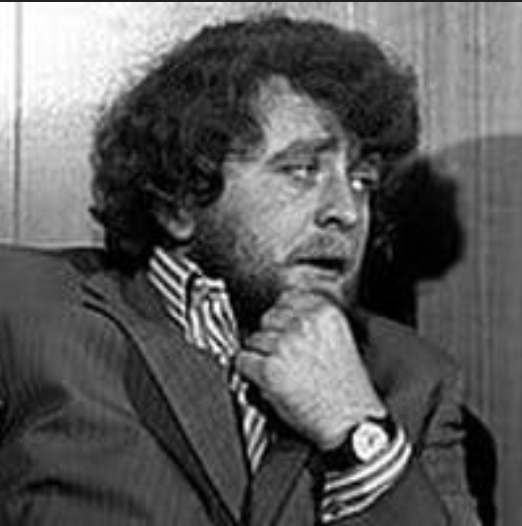 Davy Payne
Davy Payne
Some months later, I came across Davy Payne in a large store when I heard my name mentioned. The caller approached but I mistakenly thought he was a Pastor friend but it was Payne. He said he wished to apologize, and so I asked why? He bluntly said he had planned to kill me. I was aware he had engaged in some peace work. I admired the people involved in that peace work. Davy Payne appeared to have changed, so I encouraged his peace work and kept in touch.
Later I introduced the late Roel Kaptein, a Dutch psychoanalyst and former Reformed Pastor, to John McMichael at UDA Headquarters. I had enjoyed Roel’s dynamic workshops on violence and scapegoating but while waiting with Roel, Davy Payne appeared on a balcony pretending to point a gun and pull the trigger. I realized my first reaction on the Shankill was right and was advised never again to be in the same building if Payne was also in the building.
5. Rumours about the murder of John McMichael of the UDA.
John McMichael was moving the UDA towards politics and Roel suggested they work at ground level and leave the politicians with no reasonable grounds to oppose them. McMichael faced serious threats and when he arrived Roel sat at a table facing John while they talked. Roel understood the cycles of violence, and encouraged John to have his people work at ground level and drew one of his well-known illustrations on paper. This would leave the politicians free to get on with their politics and they might be less inclined to attack John McMichael’s people. John accepted the point and took Roel’s advice seriously. 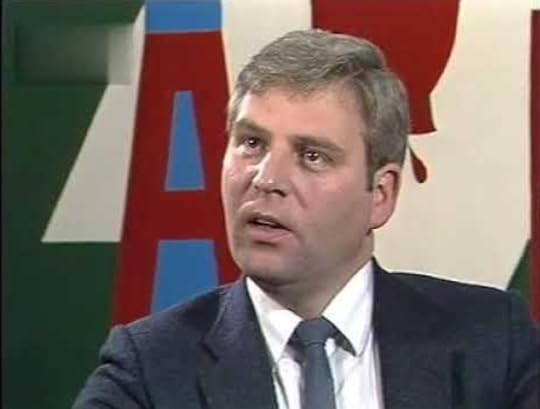 John McMichael
John McMichael
I had met John before at a peace conference when working with Father Henry Grant. John privately asked if Henry was a Jesuit priest? I said I understood he was, and this satisfied him. I found it difficult to arrange another meeting with John McMichael but learned he was murdered in an IRA bombing near his own home. Rumours suggested that some Loyalists colluded in his killing. I attended his funeral service, but the Minister seemed to know little of John’s patient work for peace, but Cardinal Tomás Ó Fiaich encouraged his work.
A friend once told me that most feuds between Loyalists were instigated by an Intelligence Agency.
6. A warning from Jay Wyatt of Tara.
Jay Wyatt was a member of Tara. He was involved in missions to smuggle arms to Northern Ireland for McGrath.
Wyatt told me my assassination was planned to take place at my shop on the Old Lodge Road in the mid 1970s, but I had closed the business for the last time, so was not there when the killers arrived.
Jay later died in a “swimming accident” but had told me about a meeting at Faith House in the 1970s where a man believed to be MI5 was introduced as an “under-secretary.” Jay had been to Holland where he saw an enormous quantity of assorted weapons in a house there, but police had followed Tara on the same ship, which created difficulties for them.
I was not aware that McGrath was looking for guns in Holland but I knew some of his contacts in Holland. They contacted me having heard allegations of abuse. I warned the Dutch people that at least some of the stories they had heard about McGrath were true.
Weapons were found under Jay’s bed, and so Jay ended up on remand in prison, but was not charged with an offence.
While he was in prison, Wyatt met an RUC man who I believe, was a former member of Ireland’s Heritage Orange Order Lodge. It was run by McGrath. The RUC man asked Jay if he knew a named Unionist? Jay denied knowing him but actually knew him well.
7. A suspected Scottish hitman.
I believe another attempt on my life involved hit men posing as roofers near my house.
I was once a member of the Ulster Defence Regiment (UDR). As I returned from work one morning, I noticed men working on the roof of a house opposite. It wasn’t long before one of the roofers came down the lane to the rear of our home. He was well-built, had tattoos on his arms and spoke with a Scottish accent. We told him we didn’t need work done to the roof. He silently sized up the situation for a few moments before departing.
My neighbour was suspicious about the roofers. One day she came across the street with her receipt which had a Shankill Road address suggesting the killing was to be seen as part of a Loyalist feud.
DISCLAIMER: This email and any files transmitted with it are confidential and intended solely for the intended recipient. If you are not the named addressee you should not disseminate, distribute, copy or alter this email. Any views or opinions presented in this email are solely those of the author and might not represent those of The Bar of Ireland. Warning: Although The Bar of Ireland has taken reasonable precautions to ensure no viruses are present in this email, the company cannot accept responsibility for any loss or damage arising from the use of this email or attachments. You are requested to carry out your own virus check before opening any attachment. The author and The Bar of Ireland accept no liability for any loss or damage which may be caused by software viruses.
Ed Moloney's Blog
- Ed Moloney's profile
- 42 followers



